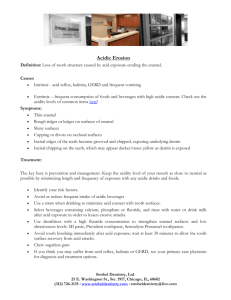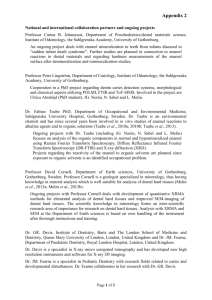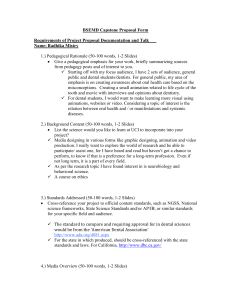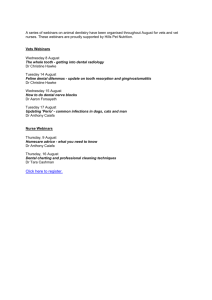Tooth Development
advertisement
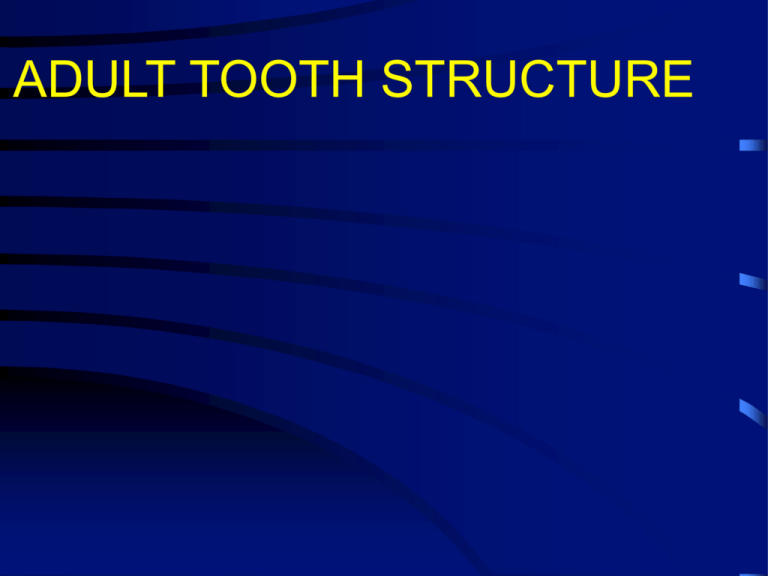
ADULT TOOTH STRUCTURE Teeth 1. In adult humans there are 32 permanent teeth. 2. These are preceded during childhood by 20 deciduous teeth. 3. The tooth lies in a bony socket, the alveolus, that is covered my an oral mucosa called the gingiva (gums) that consist of, a. keratinized stratified squamous epithelium b. lamina propria of loose connective tissue that lies directly adjacent to the bone of the alveolus. The tooth consists of two major parts, a. the crown - the portion that protrudes above the gum line and is covered by enamel. and b. the root - the portion that extends into the alveolus. Internally, the tooth consists of a layer of dentin that surrounds a pulp consisting of loose connective tissue, nerves and blood vessels. In the dentin, directly adjacent to the pulp is a layer of specialized cells called odontoblasts secrete organic matrix that mineralizes and forms the dentin. Crown region Dentin is covered by a layer of calcified organic matrix - the enamel a. Hardest substance in body b. Formed by cells called ameloblasts before tooth “erupts” from socket Root region Dentin is covered by calcified organic matrix - the cementum - similar to bone, but no haversian system Between the cementum and the bone of the socket lies the periodontal ligament - consists of fibroblasts and collagen fibers with glycosaminoglycans in between. a. forms cushion between tooth and bone b. Attaches tooth to bone - Sharpey’s fibers http://www.odont.uio.no/studier/ressurser/histologi/snitt/snitt.php?size=2&katalog=043&info=&large= http://www.odont.uio.no/studier/ressurser/histologi/snitt/snitt.php?katalog=043&size=2&quiz=true http://www.odont.uio.no/studier/ressurser/histologi/snitt/snitt.php?katalog=043&info=&large= TOOTH DEVELOPMENT http://en.wikipedia.org/wiki/Image:Molarsindevelopment11-24-05.jpg There are a number of terminologies that are used to describe the early development of teeth prior to the cap stage. In some cases, there is disagreement about what a given term represents (e.g. dental lamina, tooth bud). The following description of tooth development tries to make sense out of the available reference material I’ve been able to find; however, be aware that you may see other terminologies used in dental school. 7 1. Prior to the 5th - 6th week of gestation in human embryos, the developing jaws are solid masses of tissue with little differentiation. 2. Tooth development begins during the 5th - 6th week of gestation. 8 3. The first indication is the appearance of a thickened plate of epithelium (vestibular lamina = labialgingival lamina) between the tongue and the jaw. This, and the following events occur in both the upper and lower jaw. 4. This thickened epithelium spreads over the jaw surface. 5. An invagination (labial groove = labiogingival groove) forms in this thickened epithelium. This becomes the vestibule that separates the lip or cheek from the gum. http://dentaldominion.blogspot.com/2 011/09/dental-lamina.html 9 6. The vestibular lamina overlying the forming gums grows into the underlying gum tissue and forms the dental lamina. Neural crest cells in the underlying mesenchyme of the gums induce the formation of the dental lamina. The dental lamina forms a C-shaped band of tissue in the gums of the upper and lower jaw that is also called the dental ledge. This ingrowth of the dental lamina is sometimes called the tooth bud. A - dental lamina = dental ledge; B - Mesenchymal containing neural crest cells http://www.slideshare.net/MPDODZ/odontogenesis-10680431 6. The vestibular lamina overlying the forming gums grows into the underlying gum tissue and forms the dental lamina. Neural crest cells in the underlying mesenchyme of the gums induce the formation of the dental lamina. The dental lamina forms a C-shaped band of tissue in the gums of the upper and lower jaw that is also called the dental ledge. http://dentaldominion.blogspot.com/2011/09/dental-lamina.html Carlson, P. 530 P. 530, Fig. 16-14, Carlson 7. In 10 distinct regions of each jaw (maxilla and mandible), the cells of the dental ledge proliferate rapidly by mitosis forming a cup-shaped structure called the enamel organ (A) that is surrounded by jaw mesenchyme. The enamel organ remains connected to the labialgingival or vestibular lamina by the cord-like remains of the dental ledge (B). 8. Five enamel organs will develop on both the right and left sides of both the upper and lower jaw. These will form the child’s “milk” (primary)teeth. Enamel organ http://www.slideshare.net/MPDODZ/odontogenesis-10680431 http://32teethonline.com/pedopage2.htm 9. The mesenchyme that fills the enamel organ cup will become the dental papilla (D) that eventually forms the dentin and the pulp of the tooth. 10. The enamel organ and dental papilla are surrounded by a sheath of connective tissue called the dental sac (E). 11. The entire structure is called the cap stage of tooth development. A, Enamel organ; B, Dental lamina; C, Vestibular lamina; D, Dental Papilla; E, Dental sac http://www.slideshare.net/MPDODZ/odontogenesis-10680431 Carlson, P. 530 12. The cap stage of tooth development continues to differentiate, forming the bell stage. Concurrent with this, the successional lamina (D), that will form the secondary (adult) tooth later in life, forms as a outgrowth of the original dental lamina (E). 13. This differentiation includes the enamel organ. As is the case for the optic cup, the cup of the enamel organ consists of two opposing layers of cells that result from the formation of the cup. These are an inner layer of cells (adjacent to the dental papilla F) that is called the inner enamel organ epithelium (A) and an outer layer of cells (adjacent to the dental sac - G) called the outer enamel organ epithelium (B). A - Inner enamel epithelium; B - Outer enamel epithelium; C - Stellate reticulum; D - Successional lamina; E - Dental lamina; F - Dental papilla; G - Dental sac. http://www.slideshare.net/MPDODZ/odontogenesis-10680431 14. The ectodermally derived tissue between these two layers forms a matrix of cells called the stellate reticulum (C). This matrix is essentially a loose connective tissue with lots of extracellular material (mainly mucopolysaccharides) between the cells. 15. The inner enamel organ epithelium (A) will eventually differentiate into cells called ameloblasts that will be responsible for forming the enamel of the teeth. - Crown region 16. Neural crest cells in the dental papilla (F) will form an epithelial layer directly adjacent to the inner enamel organ epithelium that will differentiate into cells called odontoblasts which will be responsible for forming the tooth dentin. 17. The remainder of the dental papilla (F) will form the dental pulp of the tooth. A - Inner enamel organ epithelium; B - Outer enamel organ epithelium; C - Stellate reticulum; D Successional lamina; E - Dental lamina; F - Dental papilla; G - Dental sac. http://www.slideshare.net/MPDODZ/odontogenesis-10680431 P. 531, Fig. 16-15, Carlson Outer enamel organ epithelium Inner enamel organ epithelium Dental papilla Dental sac See Pp. 532 - 533, Figs. 16-16 and 16-17, in Carlson - similar figures Dental lamina Outer enamel organ epithelium (Inner enamel organ epithelium) Successional lamina Dental sac Dental papilla 18. The lips of the cup that forms the enamel organ are called the cervical loop. This structure consists of a portion of the inner and outer enamel epithelium at the region where they join. 19. Research indicates that the inner enamel epithelium portion of the loop is a source of stem cells for the developing ameloblasts (the cells that produce the tooth enamel). The cervical loop will partially degenerate as the root of the tooth develops and will become Hertwig's Epithelial Root Sheath. In species with continuously growing teeth (e.g. rodents), the cervical loop is retained through adulthood, thus emphasizing its importance in providing stem cells to produce ameloblasts for enamel formation. A - Inner enamel epithelium; B - Outer enamel epithelium; C - Stellate reticulum; D - Successional lamina; E - Dental lamina; F - Dental papilla; G - Dental sac. A, Cervical loop; B, Inner enamel epithelium; C, Outer enamel epithelium; D, Stratum intermedium; E, Stellate reticulum http://www.slideshare.net/MPDODZ/odontogenesis-10680431 20. As differentiation of the inner enamel epithelium proceeds, cells called preameloblasts form from the inner enamel organ epithelium, adjacent to the dental papilla. These cells induce neural crest cells in the dental papilla to differentiate into preodontoblasts. C D A - Inner enamel epithelium; B - Outer enamel epithelium; C - Stellate reticulum; D - Successional lamina; E - Dental lamina; F - Dental papilla; G - Dental sac. B A - Preameloblasts; B - Preodontoblasts; C - Stellate reticullum; D - Dental papilla http://www.slideshare.net/MPDODZ/odontogenesis-10680431 21. The preodontoblasts become odontoblasts as they begin to secrete predentin (which will become dentin). The predentin blocks nutrients from moving from the pulp to the preameloblasts. This causes the preameloblasts to become ameloblasts and begin their secretion of enamel. The odontoblasts and ameloblasts move away from each other as the dentin and enamel layers increase in thickness. 22. As this begins to occur, the developing tooth enters the crown stage. E D C B A 1 - Ameloblasts; 2 - Enamel; 3 - Dentin; 4 - Odontoblasts; 5 - Pulp A - Odontoblasts; B - Predentin; C - Ameloblasts; D - Dentin; E - Enamel http://www.histol.chuvashia.com/atlas-en/digestive-05-en.htm http://www.slideshare.net/MPDODZ/odontogenesis-10680431 Dental papilla Outer enamel organ epithelium Enamel organ (Inner enamel organ epithelium) P. 533, Fig. 16-17, Carlson 23. Once enamel depostion is completed and the crown is fully formed, the enamel organ collapses and the cells form a sheath called the reduced enamel epithelium that covers the crown of the tooth until eruption. Enamel space A - Reduced enamel epithelium; B - Maturative/protective ameloblasts; C - Capillary http://www.cram.com/flashcards/oucod-oral-histology-practical-chapter-1-odontogenesis-1727662 Pictures start on slide 56 24. Following the formation of the crown, the root forms. The inner and outer enamel epithelial layers of the cervical loop region continue to grow toward the future base of the tooth. (Hertwig’s epithelial root sheath). 25. The root sheath induces neural crest cells in the pulp mesenchyme to differentiate into additional odontoblasts that form the dentin of the root. 26. The central region of the root is called the radicular pulp cavity. D C B F E A A - Epithelial diaphragm; B - Radicular pulp cavity; C - Dentin; D - Enamel space; E - Alveolar Bone; F, Root http://www.cram.com/flashcards/oucod-oral-histology-practical-chapter-1-odontogenesis-1727662 Pictures start on slide 56 27. The leading edge of Hertwig’s epithelial root sheath turns inward toward the root of the tooth and forms the epithelial diaphram. D C B F E A A - Radicular pulp cavity; B - Dentin; C Dental sac; D - Point at which epithelial root sheath begins to disintegrate; E - Epithelial diaphram; F - Epithelial rests A - Epithelial diaphragm; B - Radicular pulp cavity; C - Dentin; D - Enamel space; E - Alveolar Bone; F, Root http://www.cram.com/flashcards/oucod-oral-histology-practical-chapter-1-odontogenesis-1727662 Pictures start on slide 56 28. In regions where the root odontoblasts have formed and are secreting dentin, the epithelial root sheath begins to break down. At this time, cells from the dental sac that surrounds the developing tooth migrate to the surface of the newly formed dentin and become cementoblasts. These cells secrete the cementum layer that acts as an attachment region for the peridontal ligaments that bind the root of the tooth to the bone. A - Radicular pulp cavity; B - Dentin; C Dental sac; D - Point at which epithelial root sheath begins to disintegrate; F cementoblasts move toward dentin; E Epithelial diaphram A - Cementoblasts; B - Odontoblasts; C - Predentin http://www.cram.com/flashcards/oucod-oral-histology-practical-chapter-1-odontogenesis-1727662 Pictures start on slide 56 29. As the epithelial root sheath degenerates it leaves small groups of cells around the root that are called epithelial rests. A - Epithelial rests; B - Mantle dentin; C - Globular dentin; D - Circumpulpal dentin http://www.cram.com/flashcards/oucod-oral-histology-practical-chapter-1-odontogenesis-1727662 Pictures start on slide 56 30. Once the tooth is fully formed it is ready to undergo eruption. This process involves active movement of the tooth such that it penetrates the gum tissues and extends above them. 31. In humans, eruption of the milk (primary) teeth generally begins in the second month after birth and continues until the end of the second year. 32. It is likely that there are a number of factors involved in eruption. While there is no consensus on the cause of tooth eruption, there seems to be agreement that root growth, alveolar bone remodeling, and possibly the peridontal ligaments are involved in this process. 33. Permanent (secondary) teeth develop in the same manner as primary teeth. The primary teeth will be replaced and 12 additional teeth (32 total) will be added to the dentition. 34. 28 of the secondary teeth erupt between the ages of 6 and 13 years. The four wisdom teeth may erupt between 17 and 21 years; however, they often remain impacted. http://www.uic.edu/classes/orla/orla312/Teeth%20in%20Function%3B%20Life%20History%20of%20Teeth.htm HYPERDONTIA THE END

